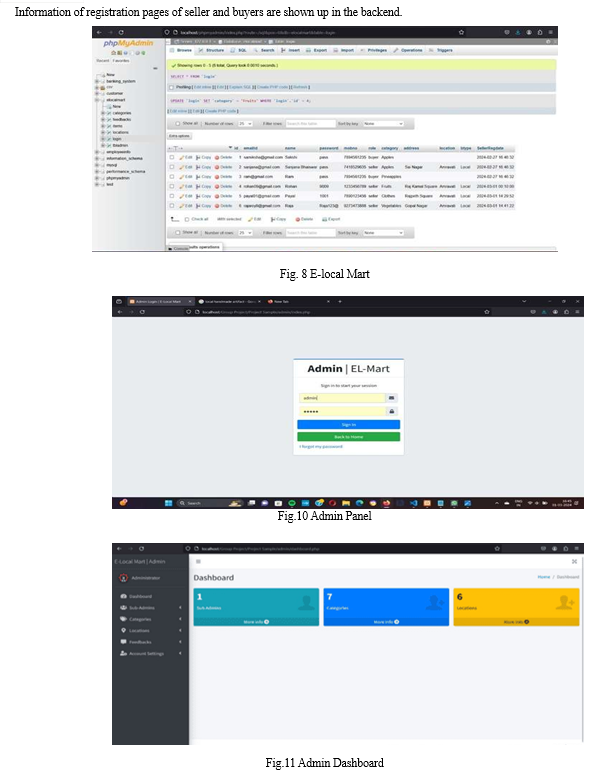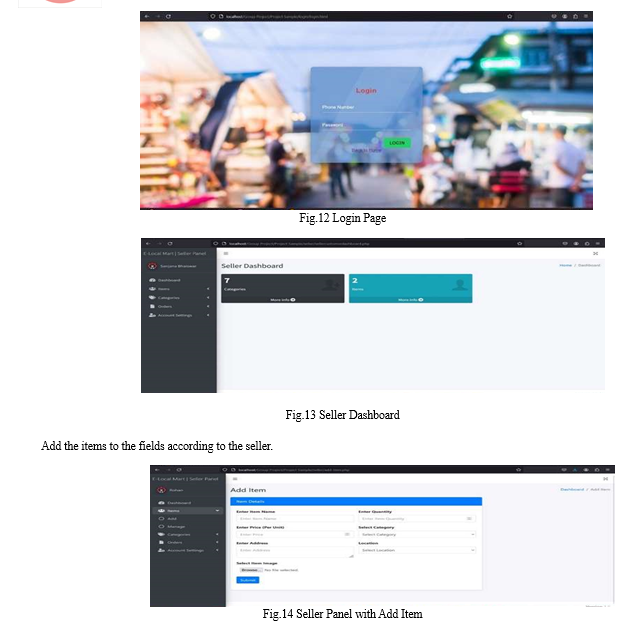Ijraset Journal For Research in Applied Science and Engineering Technology
- Home / Ijraset
- On This Page
- Abstract
- Introduction
- Conclusion
- References
- Copyright
E-local Mart Website Using Web Development
Authors: Payal Mudwani, Sanjana Bhaiswar, Samiksha Jirapure, Radhika Rithe, Dr. G. S. Thakare
DOI Link: https://doi.org/10.22214/ijraset.2024.60212
Certificate: View Certificate
Abstract
Digital technology has revolutionized the way we shop, making it easier and more convenient. In line with this, we propose the development of \"E-Local Mart,\" a new website designed for fruits, vegetables and many other products vendors and customers. This platform will serve as a digital marketplace where vendors can list their products in real-time, allowing customers to easily see what\'s available and where vendors are located. The goal is to bridge the gap between vendors and customers, making transactions more efficient and fostering a stronger community connection. Through E-Local Mart, vendors can effectively manage their inventory and reach a wider customer base, while customers gain access to a diverse range of fresh produce and the convenience of locating vendors on a map. This project aims to modernize traditional marketplaces and enhance accessibility for both vendors and customers.
Introduction
I. INTRODUCTION
In today's rapidly advancing digital landscape, the paradigm of shopping and commerce has undergone a profound evolution. Traditional marketplaces are transitioning towards online platforms, leveraging cutting-edge technologies to provide enhanced convenience to both vendors and customers. Our project, "E-Local Mart," introduces a fundamental webpage poised to revolutionize the procurement and retailing experience for fruits, vegetables, and assorted merchandise. E-Local Mart functions as a dynamic digital marketplace empowered by real-time inventory management capabilities. Vendors are equipped with intuitive tools to promptly update product availability, encompassing a diverse spectrum of offerings ranging from freshly harvested fruits to meticulously sourced vegetables and local commodities. Through our sophisticated platform architecture, vendors can seamlessly connect with potential customers, ensuring direct and efficient dissemination of their product portfolio. For customers, E-Local Mart offers an immersive and frictionless browsing experience facilitated by advanced search algorithms and location-based services. With seamless navigation, customers can effortlessly peruse a comprehensive array of fresh produce and ancillary items, augmented by pertinent insights into vendor locales and availability. The overarching objective of E-Local Mart is to bridge the gap between vendors and customers through the facilitation of transparent and expedient transactions. [1]By establishing a centralized hub for product updates and vendor geolocation data, our platform aims to augment customer accessibility while empowering vendors to optimize inventory management processes. Through E-Local Mart, we endeavour to spearhead the digital metamorphosis of traditional marketplaces, fostering a cohesive ecosystem of interconnected buyers and sellers. With the seamless integration of online accessibility and the inherent assurance of locally sourced goods, E-Local Mart endeavours to redefine the paradigm of fresh produce and essential commodity procurement.
II. LITERATURE REVIEW
Yanina Espegren and Kenneth Carling (2018) sayid that the overall response was quite in favors towards the e Business, however there were people not in favors of the idea of virtual grocery shopping. Also, the readiness to pay for convenient delivery was low, with some exceptions. The data and information gathered and resolutions obtained in some areas is not immediately available for other areas.[2] (Raja Aetal., 2023) There is still scope for exploring new supply chain models for local produce and for the initial testing and development of e commerce platforms, a virtual local produce market is suggested.
Robin Ahlers, Lars Bollweg (2018) had previously said that Local Owner Operated Retail Outlets (LOOROs) have been put under pressure by the increasing competition for virtualization. Community market places seem to be a stable approach for LOOROs to deal with the pressure of virtualization and to overcome their difficulties such as location and stocking making them unprofitable compared to virtual competitors. Although, there is still much to discover about the local shopkeepers and the buyers tendencies.[2] Our studies also show that local shopkeepers have a virtual service channel within the city/locality area and supports their virtual visibility.
Local Shopkeeper even after extending so much effort often misses the opportunity to reach inter-national shopping places. Local visitors do not explore across product and offers instead stick to the single product.
Marko D. Petrovic and Alfonso Morales (2021) had mentioned that the Local vendors and street market reflects the significance of business in a commune and the beginning of the rural to urban transformation in the society. Agriculture produces and other goods, articles in the markets very commonly come from a developed surrounding and upgrading society, so both play a crucial role in relocation, barter for goods, services, and development of the town/city. The study focuses on understanding the societal gaps of the organization and the way the market works, to provide detailed information into the modern marketing techniques and also decision-making, also to lay down the possibilities of this modern day of business.[2] By utilizing the information and the statistics of the data, the outcome will be further evaluated and assessed for societal and economic development of virtual business.
*Additionally, we have included the functionalities to the existing Neighbourhood Shop frameworks such as:
- Map Esteem: Offer help Clients in coming to Merchants effortlessly.
- Buyer Pannel: Shows up enrolled seller's List for buyers to pinpoint the closest shipper and confirm thing availability.
- Translator Esteem: Blessing’s clients to select their favoured Tongue for examining the website.
- search Esteem: Locks in buyers to see for things based on Parameters such as Seller-Name, Extend, Product-Name.
- Category Choice for Dealers: Dealers can select extra categories without the required for re-registration.
- Adding Custom category: Licenses Vendors to show unused categories not as of by and by recorded on the zone by infers of the "others" section.
III. METHODOLOGY
Basically, the website is about to give a platform to the road-side vendors to sell their items to get more earning, and it is also about to help buyers find out all details of items and their exact location so that they can directly reach them to buy the item. The website consists of various modules such as Home, Categories, About Us, Maps, Registration, and Admin, etc.
A. Dashboard:
The website comprise of three dashboard includes:
- Dashboard for Admin: It is usually used for viewing the registered users—buyers and sellers. From here, we can also add the categories by ourselves, delete the categories, and update it if any changes are required. Here all the registered buyer and seller data is also identity, and the admin manages all the entries done on the website. It also consists of a location where admins can manually add, delete, or manage the location entry if any false entry is done by mistake, and we can also update it in a module. Additionally, here we also have one to change the password if admin forgets his password, and here admin can also add the sub admin to manage the website administration section. [3]At last, we can check all activities done in the module or the changes on the dashboard, using the logout option to go outside of the modules.
- Dashboard for Sellers: Firstly, the user has to register on the site, then only he can get access to enter in the seller panel, where the seller can add categories if it is not present on the website to add his item under the category, or they can choose other options and also delete the category after it is used. It is also consisting item section where seller have to add the details of item such as Name of the item, Quantity, Price, Adress where it is available, image of item, also can choose category under which they can sell. Whatever items are added by the seller will be viewed on the dashboard. Here, the seller can also manage his or her profile to check all the updates done on site. [4]After completing their usage, they can log out of the panel and directly come to the homepage.
- Dashboard for Buyers: In this buyer has to register, then only he/she can get access to view all the products that are added by the seller according to their categories, and also the buyer can find out this exact location for the selected items. They also find out all the details regarding their product such as price, quantity, and availability, but if they are not able to find out the exact location, then he/she can contact the seller for his/her exact location. All these things will be covered in the buyer's section, and after their use, they can also logout from the panel and directly go back to the homepage.

B. Modules
- Homepage: Homepage is usually consisting of header section, body and footer section. Header section involves a logo, nav bar, search bar, etc., which have different properties and functions. A logo defines specific marks that are not used by other website holders; the icon represents the brand to sell the product. [5]Navbar consists of options such as home, category, map, register, search, etc. The body involves the responsive images of adds to sell products. The footer section involves the motive of the website, different sites to connect to, and contact information for the website owner.
- Categories: Categories module basically involves categories such as fruits, vegetables, dairy products, clothes, etc., which are added by the administrator or seller. They can also add the new category if it is not present in the seller panel. Category usually tells us about all details of items such as price, quantity, location, seller name, and name of item, etc.
- About us: About us explains the mission and vision of the website, including how the website is beneficial to the customer and whether it fulfils all the needs of the seller so that they can profit from it.
- Map: A map is used for directing the current location of the seller to the buyer so that they can easily find out the path and make the shopping easier.
- Register: The registration consists of two forms: seller and buyer. In the seller form, they have to fill in all the correct information, which is basic, such as name, email, contact number, passwords, business type, and category of product, then click the submit button. This is the same for the buyer as well.
- Login: The login form also involves the two-section admin and buyer and seller logins. After the successful registration, the seller or buyer can easily get to the panel with their contact number and password. so that seller can easily add this product or buyer can easily find out this product. They do not have to repeatedly register every time.
- Contact us: In contact with us, all the information about the website owner is given so that if a seller or buyer has any doubt or query, they can directly contact them.
IV. DISCUSSION
Digital technology has revolutionized the way we shop, making it easier and more convenient. In line with this, we propose the development of "E-Local Mart," a new website designed for fruits , vegetables and many other products vendors and customers.





Conclusion
The proposed development of \"E-Local Mart\" represents a significant step towards modernizing traditional marketplaces and enhancing accessibility for both vendors and customers. By leveraging digital technology to create a real-time marketplace for fruits, vegetables, and other products, this platform aims to bridge the gap between vendors and customers, making transactions more efficient and fostering stronger community connections. Through E-Local Mart, vendors can manage their inventory effectively, reach a wider customer base, and improve their overall business operations. Similarly, customers benefit from access to a diverse range of fresh produce and the convenience of locating vendors on a map. Overall, E-Local Mart has the potential to revolutionize the shopping experience, bringing convenience, efficiency, and community connection to the forefront of online commerce.
References
[1] R. Ahlers et al., “Are local retailers conquering the long tail? A web usage and association rule mining approach on local shopping platforms,” MKWI 2018 - Multikonferenz Wirtschaftsinformatik, vol. 2018–March, no. March, pp. 1694–1705, 2018. [2] T. P. Raja A, M. M. Iqbal, K. Gayatri, H. Ramessh, and A. Raj David, “Analysis Of Online Marketplace For Local Vendors in particular relation to Local vendors in Bangalore,” 2023. [Online]. Available: www.ijcrt.org [3] Y. Espegren, K. Carling, and C. Olsmats, “Smart online grocery delivery and peri-urban consumers ’ attitudes Working papers in transport , tourism , information technology and microdata analysis Smart online grocery delivery and peri- urban consumers ’ attitudes Författare 1?: Yanina Espegren För,” no. July, 2018, doi: 10.13140/RG.2.2.24827.41765. [4] H. Kaur and R. K. Shukla, “Consumer’s Attitude for Acceptance of Online Grocery Shopping in India,” nternational Journal of Current Research, vol. 9, no. 5, pp. 50776–50784, 2017, [Online]. Available: https://www.researchgate.net/publication/318362481 [5] S. Wang, Y. Hong, N. Archer, and Y. Wang, “Modeling the success of small and medium sized online vendors in business to business electronic marketplaces in china: A motivation - Capability framework,” Journal of Global Information Management, vol. 19, no. 4, pp. 45–75, 2011, doi: 10.4018/jgim.2011100103.
Copyright
Copyright © 2024 Payal Mudwani, Sanjana Bhaiswar, Samiksha Jirapure, Radhika Rithe, Dr. G. S. Thakare. This is an open access article distributed under the Creative Commons Attribution License, which permits unrestricted use, distribution, and reproduction in any medium, provided the original work is properly cited.

Download Paper
Paper Id : IJRASET60212
Publish Date : 2024-04-12
ISSN : 2321-9653
Publisher Name : IJRASET
DOI Link : Click Here
 Submit Paper Online
Submit Paper Online

